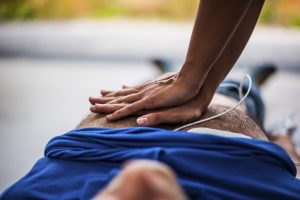I was CPR certified once. I don’t remember anymore why I was trained — I think it may have been a requirement for school? What I do remember is that the whole process was surprisingly complicated. This many chest compressions followed by that many breaths. Check here for a pulse. Make sure airways are clear. Don’t forget to call 911.
My certification lasted for a year, and they gave me a card to keep in my wallet. I remember carrying it dutifully for months, even despite admitting to myself fairly early on that the training hadn’t stuck and I would be of zero use in an actual emergency.
 Fast forward a decade to last month, when everyone in my lab participated in an hourlong CPR training class led by Lynne Farrow from the CPR Training Center. To say the least, the CPR that Farrow taught us was not what I learned in high school. This was simpler, easier and involved 100 percent less sort-of-kissing possible strangers. (I seem to recall that part being especially stressful for me as an adolescent.) Farrow taught us a technique called Hands-Only CPR, which involves only two steps for bystanders to take in the event of an emergency: call 911, and perform chest compressions. That’s it.
Fast forward a decade to last month, when everyone in my lab participated in an hourlong CPR training class led by Lynne Farrow from the CPR Training Center. To say the least, the CPR that Farrow taught us was not what I learned in high school. This was simpler, easier and involved 100 percent less sort-of-kissing possible strangers. (I seem to recall that part being especially stressful for me as an adolescent.) Farrow taught us a technique called Hands-Only CPR, which involves only two steps for bystanders to take in the event of an emergency: call 911, and perform chest compressions. That’s it.
If you’re taking the five minutes to read this blog post, please take two more to watch this great video about disco music and Hands-Only CPR. For those of you who skipped the video, here’s the punch line: To perform chest compressions, push hard and fast in the center of the chest. How fast? Sing the song “Stayin’ Alive” to yourself and push along with the beat. (We learned in our training session that singing “Call Me Maybe” works just as well.) Something tells me I’ll actually remember how to do this one for more than a few weeks.
Without a doubt, the most valuable part of the training for me was when they broke out the AEDs, or automated external defibrillators. That’s the thing that shocks the patient after the doctor yells, “Clear!” on TV. Before this training session, I had seen AEDs posted around campus, but I had only a vague notion of their purpose or how to use one. It turns out that they are shockingly easy to use — pun intended. If you see a public AED on campus, in a restaurant or at the mall, it’s there for use by ordinary people like you. It also comes with instructions — like, IKEA-level easy instructions — so you should absolutely grab it and use it if you ever find yourself responding to an unexpected medical emergency.
“Please don’t be afraid to help. The person lying in front of you is someone’s family member, friend or child,” Farrow says. “By just calling for help and starting compressions, you can help save a life.”
If you’d like to set up a CPR training session for your own group, you can contact Lynne Farrow directly.
Related Content
Visit our Health Library to learn more about CPR
The group han assesses tthe business ikpression of the catastrophe, estimating how long the disaster could disrupt enterpfise continuity.
my webhpage - Email Spike WSO
Comments are closed.